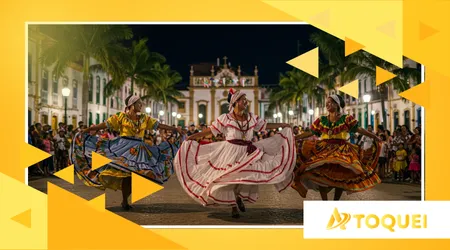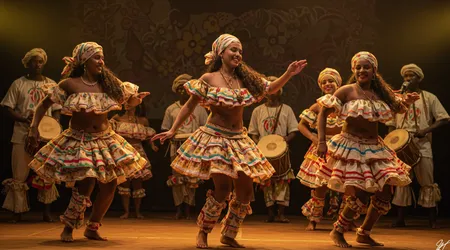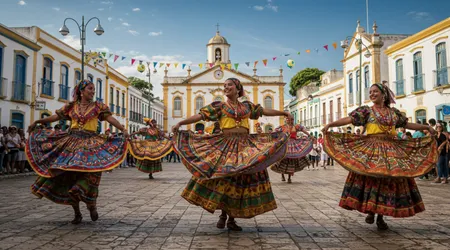Crioula Drum: Rhythm, Culture and Resistance in Maranhão

The Crioula Drum pulsates like the essence of Maranhão, uniting dance, song and percussion in a celebration of African roots.
Advertisements
This cultural manifestation, rooted in the history of resistance of enslaved peoples, transcends folklore and asserts itself as a living symbol of identity.
In 2025, with Afro-Brazilian culture in the spotlight, it gains new stages, but maintains its essence. Why does this rhythm still resonate so strongly?
Let's dive into this wheel of history, faith and movement, exploring how the Crioula Drum shapes Maranhão and Brazil.
Originating in the 19th century, the Crioula Drum It's more than a dance: it's an act of communion. Performed in honor of Saint Benedict, the patron saint of black people, it brings communities together in squares, temples, and festivals.
Advertisements
The Casa do Tambor, opened in 2018 in São Luís, reinforces its preservation, while recent events, such as National Drum Day (June 18), show its vitality.
This text reveals its layers, from the making of the drums to their cultural impact, with practical examples and current reflections.
Historical Roots: The Origin of the Tambor de Crioula
In the slave quarters of Maranhão, the Crioula Drum was born as resistance. Enslaved Africans used drumming to alleviate oppression and maintain traditions.
The dance, with its circular circle, reflects African worldviews of community.
Documents from 1818 record their recreational and religious practices, but orality is the true guardian.
Saint Benedict, a central figure, inspires devotion and unifies groups. Religious syncretism, such as the presence of voduns, enriches the ritual.
++ Caxambu and Candongueiro: Discover the Rhythms of Black Culture in Minas Gerais
The ban on Black cultural expressions forced creative adaptations. Today, the Crioula Drum is recognized as Intangible Heritage (IPHAN, 2007). Its history is a reminder: culture is survival.
The 20% increase in groups in São Luís over the past 10 years proves its expansion. Quilombos, like Santa Rita, keep the flame alive. Tradition doesn't age; it reinvents itself.

The Pair: The Sounding Heart of the Drum
Three drums form the pair: rufador, meião, and crivador. Hand-carved, they are tuned in fire, an ancient African technique. The sound is unmistakable.
The older drummer leads with improvised solos. The meião (a melody) maintains the rhythm, while the crivador adds sharp counter-beats. Rattles complement the polyrhythm, guiding the choirs.
See more: Little-Known Brazilian Instruments That Deserve to Be Highlighted
Replacing tree trunks with PVC, due to environmental restrictions, didn't change the sound. Masters like Werlys Cunha preserve the traditional craft by teaching in workshops.
In 2023, IPHAN held the Drum Excavation Workshop, training new artisans. The pair is not just sound; it is a living memory of Crioula Drum.
| Drum | Function | Traditional Material | Tuning |
|---|---|---|---|
| Drummer | Solos and improvisations | Mangrove trunk | Fire |
| Sock | Base rhythm | Pau d'arco | Fire |
| Sieve | Acute setbacks | Angelim | Fire |
Coreiras and Punga: Dance as Dialogue
The coreiras, women in full skirts, dance freely. In the center of the circle, their seductive movements echo the drums. The punga is the climax.
The belly rub, or punga, is an invitation: one coreira touches another's belly, passing the spotlight. This gesture symbolizes fertility and community connection.
Colorful costumes, with floral prints and lace, accentuate the dance's rhythm. Anastácia Diniz, a choreographer for 30 years, says: "Dancing is praying with the body."
See also: How to Preserve Handmade Percussion Instruments
Workshops at Casa do Tambor teach steps and skirt making. The dance requires no rehearsal; it's spontaneous, but it demands energy and total dedication.
Cultural Resistance: A Living Symbol
THE Crioula Drum It's Black resistance. During slavery, it was a code of communication between quilombos. Today, it combats racism and strengthens identities.
Recognized by IPHAN in 2007, it emerged from marginality to elite stages. Events such as the Encontro de Quilombos (2023) highlight its current relevance.
Casa do Tambor, in São Luís, is a center of memory and practice. Permanent exhibitions and recording studios preserve and disseminate the tradition.
Young people like 5-year-old Gabriel learn from their parents, ensuring continuity. The dance is a cry: "We are here, alive and strong."
Current Impact: Tambor de Crioula in 2025
In 2025, the Crioula Drum shines in cultural tourism. São Luís attracts visitors with spontaneous street parties in squares and festivals like Carnival.
The novel Crossing (2022) popularized the dance, inspiring groups in São Paulo. Globalization, however, requires care not to distort tradition.
Social media amplifies your visibility. Posts from @GovernoMA on June 18, 2025, celebrated National Day, reaching thousands.
Projects like Salvaguarda (2013-2014) generate income through crafts and performances. Crioula Drum it is creative economy and Maranhão pride.
Saint Benedict: Faith and Devotion in the Wheel
Saint Benedict, the black saint, is the spiritual guide of Crioula Drum. His image, passed from hand to hand, blesses the festive circles.
The legend of Benedito turning food into roses inspires promises. Choir girls like Maria José, 71, dance to give thanks for blessings received.
Syncretism allows for the worship of entities such as Preto Velho. This flexibility keeps the dance relevant in African-American communities.
Religious festivals, such as those of the Divine Holy Spirit, include the drum. Faith is the engine that makes the wheel turn.
Practical Examples: Living the Tambor de Crioula

Imagine an afternoon at Praça Maria Aragão, São Luís. A group of choreographers form a circle, while drums echo. Visitors gather, mesmerized.
Or think of Ana Lúcia, a choreographer who taught Crioula Drum in São Paulo. In 2023, its circle brought together 50 people, expanding the culture.
Statistics: More than 200 active groups in Maranhão in 2020, according to G1. This vitality is a beacon for other Afro-Brazilian manifestations.
Analogy: The Crioula Drum It is like a river: it flows freely, but carries the strength of its sources, never forgetting its roots.
Conclusion: The Future of Tambor de Crioula
THE Crioula Drum It's more than a dance; it's a manifesto of resistance, faith, and joy. In 2025, its relevance grows, driven by initiatives such as Casa do Tambor and national events.
It unites generations, from Gabriel, 5, to Maria José, 71, in a never-ending cycle. Preservation requires balance: valuing tradition without ignoring innovation.
How do we ensure that this rhythm continues to echo?
It's up to us, admirers and practitioners, to keep this heritage alive. Join the circle, feel the beat of the drums, and celebrate Maranhão.
Frequently Asked Questions
What is the Crioula Drum?
An Afro-Brazilian dance from Maranhão, with singing, percussion and a circular circle, in praise of Saint Benedict.
Can anyone dance?
Yes! No rehearsals required, just willingness. Workshops at Casa do Tambor teach beginners.
When does it happen?
All year round, with highlights including Carnival, June festivals and June 18th, National Day.
Where to learn more?
At Casa do Tambor, in São Luís, with regular exhibitions, workshops and presentations.
